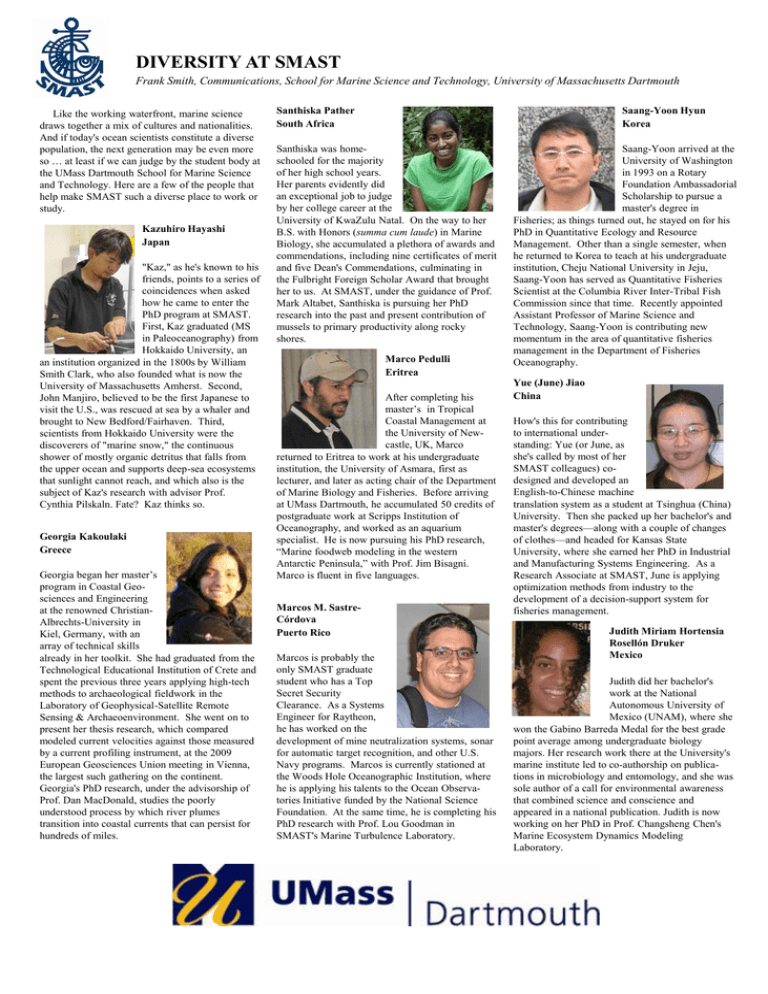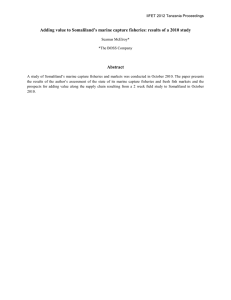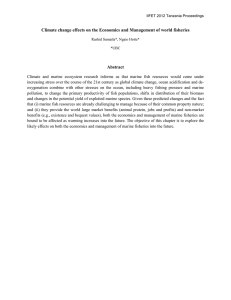diversity at smast - New Bedford Fishing Heritage Center
advertisement

DIVERSITY AT SMAST Frank Smith, Communications, School for Marine Science and Technology, University of Massachusetts Dartmouth Like the working waterfront, marine science draws together a mix of cultures and nationalities. And if today's ocean scientists constitute a diverse population, the next generation may be even more so … at least if we can judge by the student body at the UMass Dartmouth School for Marine Science and Technology. Here are a few of the people that help make SMAST such a diverse place to work or study. Kazuhiro Hayashi Japan "Kaz," as he's known to his friends, points to a series of coincidences when asked how he came to enter the PhD program at SMAST. First, Kaz graduated (MS in Paleoceanography) from Hokkaido University, an an institution organized in the 1800s by William Smith Clark, who also founded what is now the University of Massachusetts Amherst. Second, John Manjiro, believed to be the first Japanese to visit the U.S., was rescued at sea by a whaler and brought to New Bedford/Fairhaven. Third, scientists from Hokkaido University were the discoverers of "marine snow," the continuous shower of mostly organic detritus that falls from the upper ocean and supports deep-sea ecosystems that sunlight cannot reach, and which also is the subject of Kaz's research with advisor Prof. Cynthia Pilskaln. Fate? Kaz thinks so. Georgia Kakoulaki Greece Georgia began her master’s program in Coastal Geosciences and Engineering at the renowned ChristianAlbrechts-University in Kiel, Germany, with an array of technical skills already in her toolkit. She had graduated from the Technological Educational Institution of Crete and spent the previous three years applying high-tech methods to archaeological fieldwork in the Laboratory of Geophysical-Satellite Remote Sensing & Archaeoenvironment. She went on to present her thesis research, which compared modeled current velocities against those measured by a current profiling instrument, at the 2009 European Geosciences Union meeting in Vienna, the largest such gathering on the continent. Georgia's PhD research, under the advisorship of Prof. Dan MacDonald, studies the poorly understood process by which river plumes transition into coastal currents that can persist for hundreds of miles. Santhiska Pather South Africa Saang-Yoon Hyun Korea Santhiska was homeschooled for the majority of her high school years. Her parents evidently did an exceptional job to judge by her college career at the University of KwaZulu Natal. On the way to her B.S. with Honors (summa cum laude) in Marine Biology, she accumulated a plethora of awards and commendations, including nine certificates of merit and five Dean's Commendations, culminating in the Fulbright Foreign Scholar Award that brought her to us. At SMAST, under the guidance of Prof. Mark Altabet, Santhiska is pursuing her PhD research into the past and present contribution of mussels to primary productivity along rocky shores. Marco Pedulli Eritrea After completing his master’s in Tropical Coastal Management at the University of Newcastle, UK, Marco returned to Eritrea to work at his undergraduate institution, the University of Asmara, first as lecturer, and later as acting chair of the Department of Marine Biology and Fisheries. Before arriving at UMass Dartmouth, he accumulated 50 credits of postgraduate work at Scripps Institution of Oceanography, and worked as an aquarium specialist. He is now pursuing his PhD research, “Marine foodweb modeling in the western Antarctic Peninsula,” with Prof. Jim Bisagni. Marco is fluent in five languages. Marcos M. SastreCórdova Puerto Rico Marcos is probably the only SMAST graduate student who has a Top Secret Security Clearance. As a Systems Engineer for Raytheon, he has worked on the development of mine neutralization systems, sonar for automatic target recognition, and other U.S. Navy programs. Marcos is currently stationed at the Woods Hole Oceanographic Institution, where he is applying his talents to the Ocean Observatories Initiative funded by the National Science Foundation. At the same time, he is completing his PhD research with Prof. Lou Goodman in SMAST's Marine Turbulence Laboratory. Saang-Yoon arrived at the University of Washington in 1993 on a Rotary Foundation Ambassadorial Scholarship to pursue a master's degree in Fisheries; as things turned out, he stayed on for his PhD in Quantitative Ecology and Resource Management. Other than a single semester, when he returned to Korea to teach at his undergraduate institution, Cheju National University in Jeju, Saang-Yoon has served as Quantitative Fisheries Scientist at the Columbia River Inter-Tribal Fish Commission since that time. Recently appointed Assistant Professor of Marine Science and Technology, Saang-Yoon is contributing new momentum in the area of quantitative fisheries management in the Department of Fisheries Oceanography. Yue (June) Jiao China How's this for contributing to international understanding: Yue (or June, as she's called by most of her SMAST colleagues) codesigned and developed an English-to-Chinese machine translation system as a student at Tsinghua (China) University. Then she packed up her bachelor's and master's degrees—along with a couple of changes of clothes—and headed for Kansas State University, where she earned her PhD in Industrial and Manufacturing Systems Engineering. As a Research Associate at SMAST, June is applying optimization methods from industry to the development of a decision-support system for fisheries management. Judith Miriam Hortensia Rosellón Druker Mexico Judith did her bachelor's work at the National Autonomous University of Mexico (UNAM), where she won the Gabino Barreda Medal for the best grade point average among undergraduate biology majors. Her research work there at the University's marine institute led to co-authorship on publications in microbiology and entomology, and she was sole author of a call for environmental awareness that combined science and conscience and appeared in a national publication. Judith is now working on her PhD in Prof. Changsheng Chen's Marine Ecosystem Dynamics Modeling Laboratory.





